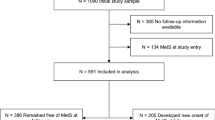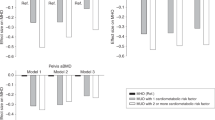Abstract
Objective:
To assess the prevalence of overweight, obesity and physical inactivity in 20- to 29-year-old men and to analyze whether sociodemography, physical dysfunction and low socioeconomic status are independent correlates of obesity and physical inactivity.
Design:
Population-based, cross-sectional study.
Subjects:
Seven hundred and eighty-three Caucasian, Danish men, aged 20–29 years recruited from 2042 respondents in a questionnaire survey of 3000 men, randomly drawn from the Danish Civil Registration System.
Methods:
Questionnaire, interview and physical examination.
Results:
The 783 included men and the 2042 questionnaire respondents matched the background population demographically. The 783 men matched the questionnaire respondents as regards BMI, physical activity, chronic disease, medication, smoking, sociodemography and socioeconomic status. The prevalence of overweight and obesity was 31.7 and 7.9%, respectively (World Health Organization criteria). Using waist circumference (WC) cutoffs of 94 and 102 cm, the prevalence was 16.2 and 10.6%, respectively; 24.4% were physically inactive. BMI and WC increased significantly from age 20 to 29 years. Physical activity decreased significantly with age and correlated inversely with WC, but not with BMI. Occupation, geography, partner status, fatherhood and tobacco exposure were independently related with obesity and physical inactivity. Obesity was also related to musculoskeletal complaints, whereas chronic diseases and low educational level were associated with physical inactivity. Age was not independently related with either outcome.
Conclusion:
In affluent societies, sociodemographic changes may partly explain the age-related decrease in physical activity and the parallel increase in WC and BMI.
This is a preview of subscription content, access via your institution
Access options
Subscribe to this journal
Receive 12 print issues and online access
$259.00 per year
only $21.58 per issue
Buy this article
- Purchase on Springer Link
- Instant access to full article PDF
Prices may be subject to local taxes which are calculated during checkout
Similar content being viewed by others
References
Mokdad AH, Marks JS, Stroup DF, Gerberding JL . Actual causes of death in the United States, 2000. JAMA 2004; 291: 1238–1245.
Luke DA, Stamatakis KA, Brownson RC . State youth-access tobacco control policies and youth smoking behavior in the United States. Am J Prev Med 2000; 19: 180–187.
Bendixen H, Holst C, Sorensen TIA, Raben A, Bartels EM, Astrup A . Major increase in prevalence of overweight and obesity between 1987 and 2001 among Danish adults. Obes Res 2004; 12: 1464–1472.
Heitmann BL . Ten-year trends in overweight and obesity among Danish men and women aged 30–60 years. Int J Obes Relat Metab Disord 2000; 24: 1347–1352.
Midthjell K, Kruger O, Holmen J, Tverdal A, Claudi T, Bjorndal A et al. Rapid changes in the prevalence of obesity and known diabetes in an adult Norwegian population. The Nord-Trondelag Health Surveys: 1984–1986 and 1995–1997. Diabetes Care 1999; 22: 1813–1820.
Mokdad AH, Ford ES, Bowman BA, Dietz WH, Vinicor F, Bales VS et al. Prevalence of obesity, diabetes, and obesity-related health risk factors, 2001. JAMA 2003; 289: 76–79.
Rasmussen F, Johansson M, Hansen HO . Trends in overweight and obesity among 18-year-old males in Sweden between 1971 and 1995. Acta Paediatr 1999; 88: 431–437.
National Centre for Social Research, Department of Epidemiology and Public Health at the Royal Free and University College Medical School. Health Survey for England 2003. Vol. 2: Risk Factors for Cardiovascular Disease. Department of Health: London, 2004.
Visscher TL, Kromhout D, Seidell JC . Long-term and recent time trends in the prevalence of obesity among Dutch men and women. Int J Obes Relat Metab Disord 2002; 26: 1218–1224.
Maes HH, Neale MC, Eaves LJ . Genetic and environmental factors in relative body weight and human adiposity. Behav Genet 1997; 27: 325–351.
Schousboe K, Willemsen G, Kyvik KO, Mortensen J, Boomsma DI, Cornes BK et al. Sex differences in heritability of BMI: a comparative study of results from twin studies in eight countries. Twin Res 2003; 6: 409–421.
Cairney J, Wade TJ . Correlates of body weight in the 1994 National Population Health Survey. Int J Obes Relat Metab Disord 1998; 22: 584–591.
Kuskowska-Wolk A, Bergstrom R . Trends in body mass index and prevalence of obesity in Swedish men 1980–89. J Epidemiol Community Health 1993; 47: 103–108.
Flegal KM, Carroll MD, Ogden CL, Johnson CL . Prevalence and trends in obesity among US adults, 1999–2000. JAMA 2002; 288: 1723–1727.
Dowda M, Ainsworth BE, Addy CL, Saunders R, Riner W . Correlates of physical activity among US young adults, 18 to 30 years of age, from NHANES III. Ann Behav Med 2003; 26: 15–23.
Kjøller M, Rasmussen NK . Danish Health and Morbidity Survey 2000. National Institute of Public Health (http://www.si-folkesundhed.dk/susy/Summary-SUSY2000.pdf): Copenhagen, 2002.
Caspersen CJ, Pereira MA, Curran KM . Changes in physical activity patterns in the United States, by sex and cross-sectional age. Med Sci Sports Exerc 2000; 32: 1601–1609.
Swinburn B, Egger G . The runaway weight gain train: too many accelerators, not enough brakes. BMJ 2004; 329: 736–739.
Gaist D . Use and overuse of sumatriptan. Pharmacoepidemiological studies based on prescription register and interview data. Cephalalgia 1999; 19: 735–761.
StatBank Denmark. Statistics Denmark (http://www.statbank.dk/): Copenhagen, 2004.
Frank L . Epidemiology. When an entire country is a cohort. Science 2000; 287: 2398–2399.
Lean ME, Han TS, Morrison CE . Waist circumference as a measure for indicating need for weight management. BMJ 1995; 311: 158–161.
Couillard C, Gagnon J, Bergeron J, Leon AS, Rao DC, Skinner JS et al. Contribution of body fatness and adipose tissue distribution to the age variation in plasma steroid hormone concentrations in men: the HERITAGE Family Study. J Clin Endocrinol Metab 2000; 85: 1026–1031.
Burke GL, Jacobs Jr DR, Sprafka JM, Savage PJ, Sidney S, Wagenknecht LE . Obesity and overweight in young adults: the CARDIA study. Prev Med 1990; 19: 476–488.
Gapstur SM, Gann PH, Kopp P, Colangelo L, Longcope C, Liu K . Serum androgen concentrations in young men: a longitudinal analysis of associations with age, obesity, and race. The CARDIA Male Hormone Study. Cancer Epidemiol Biomarkers Prev 2002; 11: 1041–1047.
Halkjaer J, Sorensen TI . Psychosocial and demographic determinants of regional differences in the prevalence of obesity. J Biosoc Sci 2004; 36: 141–152.
Kritz S, Barrett-Connor E, Friedlander NJ . Parenthood and lipid and lipoprotein levels in older men. Ann Epidemiol 1997; 7: 275–279.
Weng HH, Bastian LA, Taylor Jr DH, Moser BK, Ostbye T . Number of children associated with obesity in middle-aged women and men: results from the health and retirement study. J Womens Health (Larchmt) 2004; 13: 85–91.
Rissanen AM, Heliovaara M, Knekt P, Reunanen A, Aromaa A . Determinants of weight gain and overweight in adult Finns. Eur J Clin Nutr 1991; 45: 419–430.
WHO Expert Committee. Physical Status: the Use and Interpretation of Anthropometry, WHO Technical Report Series No. 854. World Health Organization: Geneva, 1995, p 319.
Stunkard AJ, Sorensen TIA . Obesity and socioeconomic status – a complex relation. N Engl J Med 1993; 329: 1036–1037.
Gortmaker SL, Must A, Perrin JM, Sobol AM, Dietz WH . Social and economic consequences of overweight in adolescence and young adulthood. N Engl J Med 1993; 329: 1008–1012.
Jensen TK, Andersson AM, Jorgensen N, Andersen AG, Carlsen E, Petersen JH et al. Body mass index in relation to semen quality and reproductive hormones among 1558 Danish men. Fertil Steril 2004; 82: 863–870.
Hofstetter A, Schutz Y, Jequier E, Wahren J . Increased 24-hour energy expenditure in cigarette smokers. N Engl J Med 1986; 314: 79–82.
Sobal J, Stunkard AJ . Socioeconomic status and obesity: a review of the literature. Psychol Bull 1989; 105: 260–275.
Lindstrom M, Isacsson SO, Merlo J . Increasing prevalence of overweight, obesity and physical inactivity: two population-based studies 1986 and 1994. Eur J Public Health 2003; 13: 306–312.
Sorensen HT, Sabroe S, Gillman M, Rothman KJ, Madsen KM, Fischer P et al. Continued increase in prevalence of obesity in Danish young men. Int J Obes Relat Metab Disord 1997; 21:712–714.
Hedley AA, Ogden CL, Johnson CL, Carroll MD, Curtin LR, Flegal KM . Prevalence of overweight and obesity among US children, adolescents, and adults, 1999–2002. JAMA 2004; 291: 2847–2850.
Rowland ML . Self-reported weight and height. Am J Clin Nutr 1990; 52: 1125–1133.
Palta M, Prineas RJ, Berman R, Hannan P . Comparison of self-reported and measured height and weight. Am J Epidemiol 1982; 115: 223–230.
Westerterp KR, Goran MI . Relationship between physical activity related energy expenditure and body composition: a gender difference. Int J Obes Relat Metab Disord 1997; 21: 184–188.
Schulz LO, Schoeller DA . A compilation of total daily energy expenditures and body weights in healthy adults. Am J Clin Nutr 1994; 60: 676–681.
Williamson DF, Kahn HS, Remington PL, Anda RF . The 10-year incidence of overweight and major weight gain in US adults. Arch Intern Med 1990; 150: 665–672.
Haapanen N, Miilunpalo S, Pasanen M, Oja P, Vuori I . Association between leisure time physical activity and 10-year body mass change among working-aged men and women. Int J Obes Relat Metab Disord 1997; 21: 288–296.
Deurenberg P, Andreoli A, Borg P, Kukkonen-Harjula K, De Lorenzo A, Marken Lichtenbelt WD et al. The validity of predicted body fat percentage from body mass index and from impedance in samples of five European populations. Eur J Clin Nutr 2001; 55: 973–979.
De Lorenzo A, Deurenberg P, Pietrantuono M, Di Daniele N, Cervelli V, Andreoli A . How fat is obese? Acta Diabetol 2003; 40: S254–S257.
Arroyo M, Rocandio AM, Ansotegui L, Herrera H, Salces I, Rebato E . Comparison of predicted body fat percentage from anthropometric methods and from impedance in university students. Br J Nutr 2004; 92: 827–832.
Gallagher D, Visser M, Sepulveda D, Pierson RN, Harris T, Heymsfield SB . How useful is body mass index for comparison of body fatness across age, sex, and ethnic groups? Am J Epidemiol 1996; 143: 228–239.
Sonne-Holm S, Sorensen TI, Jensen G, Schnohr P . Influence of fatness, intelligence, education and sociodemographic factors on response rate in a health survey. J Epidemiol Community Health 1989; 43: 369–374.
Frank L . Epidemiology. The epidemiologist's dream: Denmark. Science 2003; 301: 163.
Wedderkopp N, Froberg K, Hansen HS, Andersen LB . Secular trends in physical fitness and obesity in Danish 9-year-old girls and boys: Odense School Child Study and Danish substudy of the European Youth Heart Study. Scand J Med Sci Sports 2004; 14: 150–155.
Acknowledgements
This study was supported by research grants from the World Anti-Doping Agency, Novo Nordisk AB, The Danish Ministry of Culture and the Institute of Clinical Research, University of Southern Denmark.
Author information
Authors and Affiliations
Corresponding author
Rights and permissions
About this article
Cite this article
Nielsen, T., Wraae, K., Brixen, K. et al. Prevalence of overweight, obesity and physical inactivity in 20- to 29-year-old, Danish men. Relation to sociodemography, physical dysfunction and low socioeconomic status: the Odense Androgen Study. Int J Obes 30, 805–815 (2006). https://doi.org/10.1038/sj.ijo.0803197
Received:
Revised:
Accepted:
Published:
Issue Date:
DOI: https://doi.org/10.1038/sj.ijo.0803197
Keywords
This article is cited by
-
Peak muscle mass in young men and sarcopenia in the ageing male
Osteoporosis International (2015)
-
Polymorphisms of Muscle Genes Are Associated with Bone Mass and Incident Osteoporotic Fractures in Caucasians
Calcified Tissue International (2013)
-
Genetic association study of WNT10B polymorphisms with BMD and adiposity parameters in Danish and Belgian males
Endocrine (2013)
-
Resistin polymorphisms show associations with obesity, but not with bone parameters in men: results from the Odense Androgen Study
Molecular Biology Reports (2013)
-
Socioeconomic inequalities in occupational, leisure-time, and transport related physical activity among European adults: A systematic review
International Journal of Behavioral Nutrition and Physical Activity (2012)



